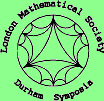 |
|
| Home | |
| Programme | |
| Short Courses | |
| Talks | |
| Posters | |
| For Presenters | |
| Participants | |
| Travel | |
| Recreation |
LMS Durham Symposium
Computational methods for wave propagation in direct scattering
Judy Bell (Heriot-Watt. UK)
Applications of wave propagation modelling in underwater acoustics
Abstract
Modelling is widely regarded as playing a critical role in enhancing understanding of underwater acoustics. It can aid in the development and testing of new processing techniques and algorithms by providing fully ground truthed data sets, as well as assisting in the planning of experiments, the design of new equipment and the training of operators. This broad range of potential applications has differing requirements on the modelling, including the accuracy required, ease of use, flexibility and the computation time.
To fulfil these wide ranging roles two complementary methods of simulating and visualising the sonar process have been developed. The Pseudospectral time domain model is an accurate and efficient scheme for solving the acoustic wave equation numerically which is based on finite difference time domain modelling. It offers the advantage of treating all aspects of the problem as an inherent part of the model and provides a highly accurate but computationally complex research tool capable of providing details of the acoustic field throughout the scene at any instant of time. The second approach, based on ray tracing, provides a more operational based approach but can provide realistic simulated sonar images and signals. This model has the flexibility to introduce a number of approximations thus decreasing the computational demands whilst attempting to maintain reasonable levels of accuracy.
The two methods have complementary roles: PSTD providing accurate benchmark calculations and providing a complex research tool; and the ray method finding application as a more operational approach. An overview of these two approaches will be presented illustrating their complementary nature and indicating the future for a hybrid approach combining the advantages of each technique.
Both models have a broad range of potential applications and have already found widespread application in the development and testing of novel image processing algorithms for improved interpretation of sonar images. Examples of these applications will be presented to illustrate the significance of the models on future research in underwater acoustics.